engine KIA Sorento 2006 1.G Manual PDF
[x] Cancel search | Manufacturer: KIA, Model Year: 2006, Model line: Sorento, Model: KIA Sorento 2006 1.GPages: 312, PDF Size: 5.21 MB
Page 229 of 312
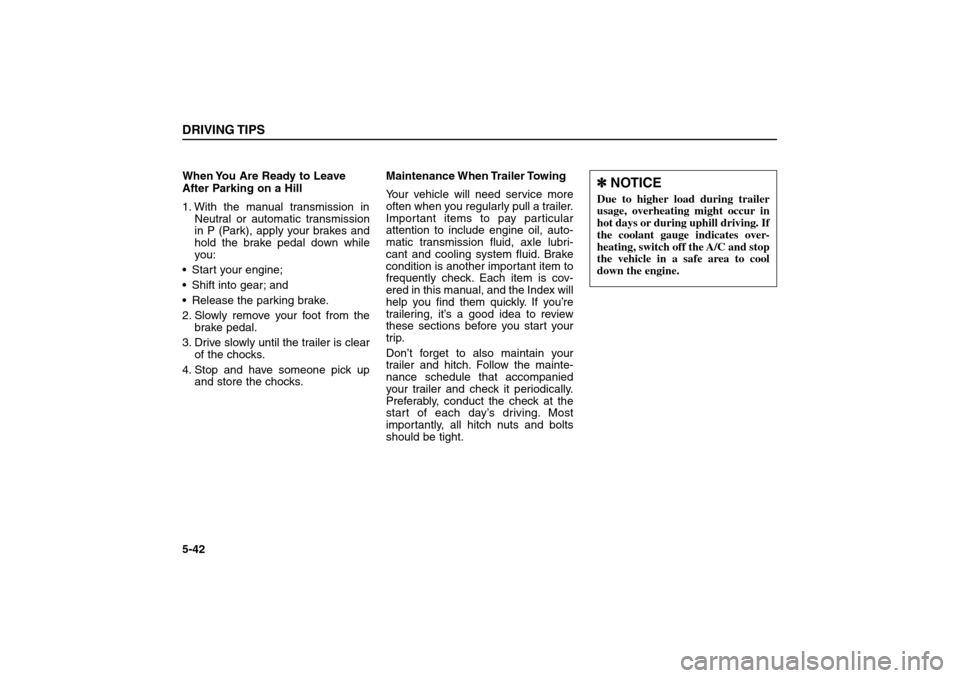
When You Are Ready to Leave
After Parking on a Hill
1. With the manual transmission in
Neutral or automatic transmission
in P (Park), apply your brakes and
hold the brake pedal down while
you:
Start your engine;
Shift into gear; and
Release the parking brake.
2. Slowly remove your foot from the
brake pedal.
3. Drive slowly until the trailer is clear
of the chocks.
4. Stop and have someone pick up
and store the chocks.Maintenance When Trailer Towing
Your vehicle will need service more
often when you regularly pull a trailer.
Important items to pay particular
attention to include engine oil, auto-
matic transmission fluid, axle lubri-
cant and cooling system fluid. Brake
condition is another important item to
frequently check. Each item is cov-
ered in this manual, and the Index will
help you find them quickly. If you’re
trailering, it’s a good idea to review
these sections before you start your
trip.
Don’t forget to also maintain your
trailer and hitch. Follow the mainte-
nance schedule that accompanied
your trailer and check it periodically.
Preferably, conduct the check at the
start of each day’s driving. Most
importantly, all hitch nuts and bolts
should be tight.DRIVING TIPS5-42
✽ ✽
NOTICEDue to higher load during trailer
usage, overheating might occur in
hot days or during uphill driving. If
the coolant gauge indicates over-
heating, switch off the A/C and stop
the vehicle in a safe area to cool
down the engine.
BL-ENG (CAN)-5.qxd 7/28/05 5:56 PM Page 42
Page 232 of 312
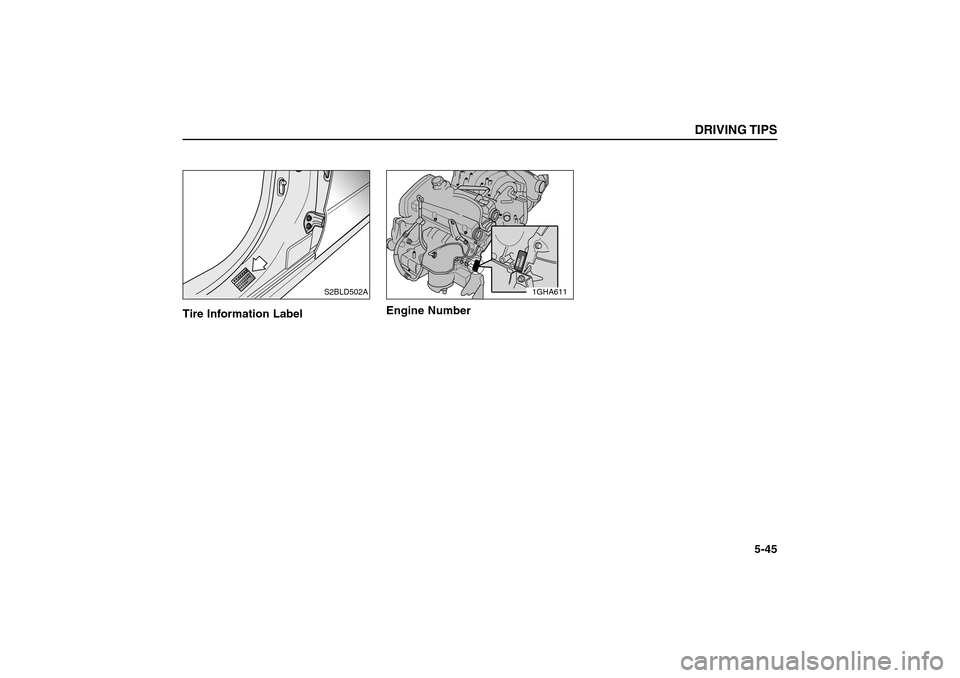
Tire Information LabelEngine Number
DRIVING TIPS
5-45
S2BLD502A
1GHA611
BL-ENG (CAN)-5.qxd 7/28/05 5:56 PM Page 45
Page 235 of 312
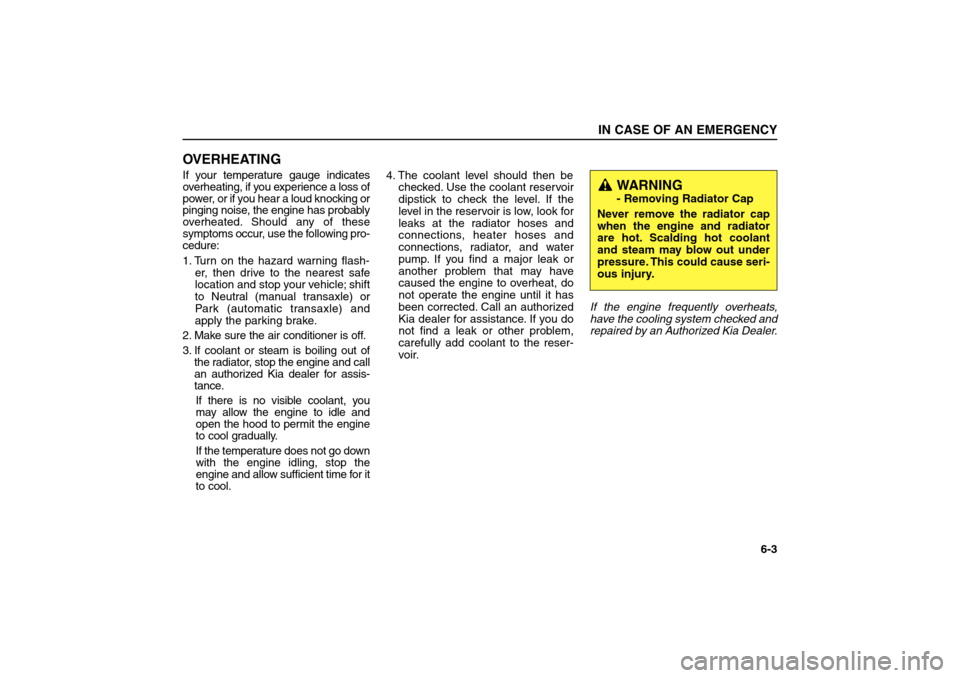
OVERHEATINGIf your temperature gauge indicates
overheating, if you experience a loss of
power, or if you hear a loud knocking or
pinging noise, the engine has probably
overheated. Should any of these
symptoms occur, use the following pro-
cedure:
1. Turn on the hazard warning flash-
er, then drive to the nearest safe
location and stop your vehicle; shift
to Neutral (manual transaxle) or
Park (automatic transaxle) and
apply the parking brake.
2. Make sure the air conditioner is off.
3. If coolant or steam is boiling out of
the radiator, stop the engine and call
an authorized Kia dealer for assis-
tance.
If there is no visible coolant, you
may allow the engine to idle and
open the hood to permit the engine
to cool gradually.
If the temperature does not go down
with the engine idling, stop the
engine and allow sufficient time for it
to cool.4. The coolant level should then be
checked. Use the coolant reservoir
dipstick to check the level. If the
level in the reservoir is low, look for
leaks at the radiator hoses and
connections, heater hoses and
connections, radiator, and water
pump. If you find a major leak or
another problem that may have
caused the engine to overheat, do
not operate the engine until it has
been corrected. Call an authorized
Kia dealer for assistance. If you do
not find a leak or other problem,
carefully add coolant to the reser-
voir.If the engine frequently overheats,
have the cooling system checked and
repaired by an Authorized Kia Dealer.
IN CASE OF AN EMERGENCY
6-3
WARNING- Removing Radiator Cap
Never remove the radiator cap
when the engine and radiator
are hot. Scalding hot coolant
and steam may blow out under
pressure. This could cause seri-
ous injury.
BL-ENG (CAN)-6.qxd 7/28/05 5:57 PM Page 3
Page 238 of 312
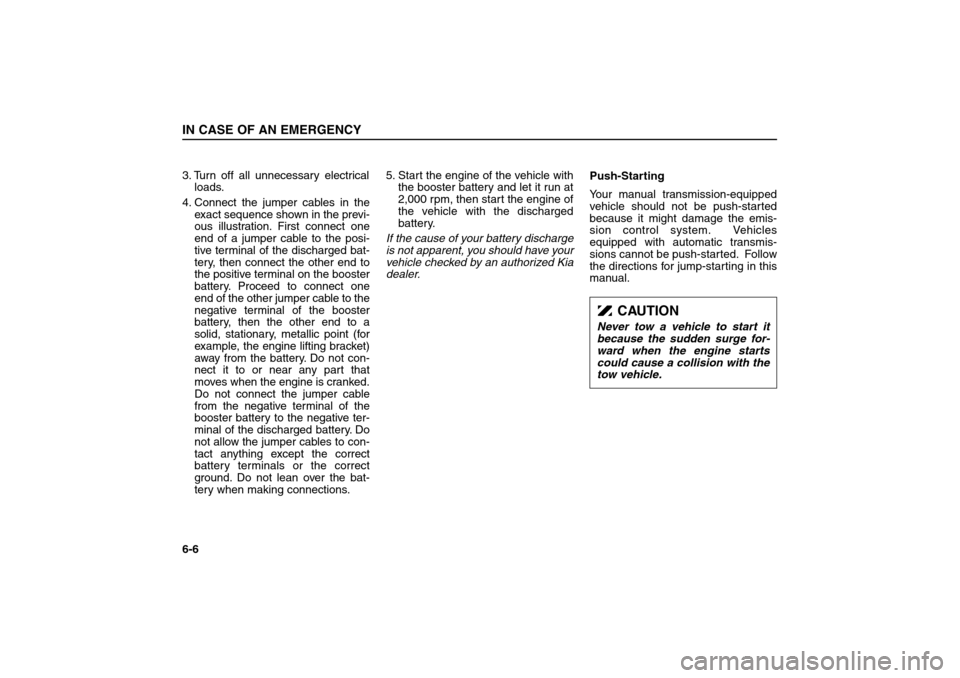
3. Turn off all unnecessary electrical
loads.
4. Connect the jumper cables in the
exact sequence shown in the previ-
ous illustration. First connect one
end of a jumper cable to the posi-
tive terminal of the discharged bat-
tery, then connect the other end to
the positive terminal on the booster
battery. Proceed to connect one
end of the other jumper cable to the
negative terminal of the booster
battery, then the other end to a
solid, stationary, metallic point (for
example, the engine lifting bracket)
away from the battery. Do not con-
nect it to or near any part that
moves when the engine is cranked.
Do not connect the jumper cable
from the negative terminal of the
booster battery to the negative ter-
minal of the discharged battery. Do
not allow the jumper cables to con-
tact anything except the correct
battery terminals or the correct
ground. Do not lean over the bat-
tery when making connections.5. Start the engine of the vehicle with
the booster battery and let it run at
2,000 rpm, then start the engine of
the vehicle with the discharged
battery.
If the cause of your battery discharge
is not apparent, you should have your
vehicle checked by an authorized Kia
dealer.Push-Starting
Your manual transmission-equipped
vehicle should not be push-started
because it might damage the emis-
sion control system. Vehicles
equipped with automatic transmis-
sions cannot be push-started. Follow
the directions for jump-starting in this
manual.IN CASE OF AN EMERGENCY6-6
CAUTION
Never tow a vehicle to start it
because the sudden surge for-
ward when the engine starts
could cause a collision with the
tow vehicle.
BL-ENG (CAN)-6.qxd 7/28/05 5:57 PM Page 6
Page 239 of 312
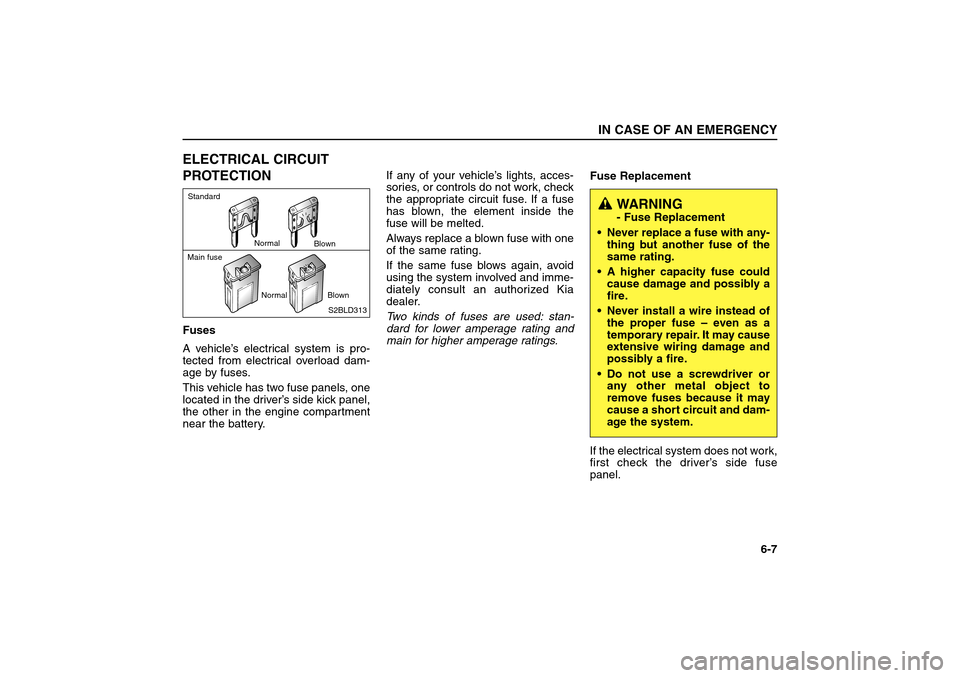
ELECTRICAL CIRCUIT
PROTECTIONFuses
A vehicle’s electrical system is pro-
tected from electrical overload dam-
age by fuses.
This vehicle has two fuse panels, one
located in the driver’s side kick panel,
the other in the engine compartment
near the battery.If any of your vehicle’s lights, acces-
sories, or controls do not work, check
the appropriate circuit fuse. If a fuse
has blown, the element inside the
fuse will be melted.
Always replace a blown fuse with one
of the same rating.
If the same fuse blows again, avoid
using the system involved and imme-
diately consult an authorized Kia
dealer.
Two kinds of fuses are used: stan-
dard for lower amperage rating and
main for higher amperage ratings.Fuse Replacement
If the electrical system does not work,
first check the driver’s side fuse
panel.
IN CASE OF AN EMERGENCY
6-7
S2BLD313
StandardMain fuseNormal
Blown
NormalBlown
WARNING- Fuse Replacement
Never replace a fuse with any-
thing but another fuse of the
same rating.
A higher capacity fuse could
cause damage and possibly a
fire.
Never install a wire instead of
the proper fuse – even as a
temporary repair. It may cause
extensive wiring damage and
possibly a fire.
Do not use a screwdriver or
any other metal object to
remove fuses because it may
cause a short circuit and dam-
age the system.
BL-ENG (CAN)-6.qxd 7/28/05 5:57 PM Page 7
Page 240 of 312
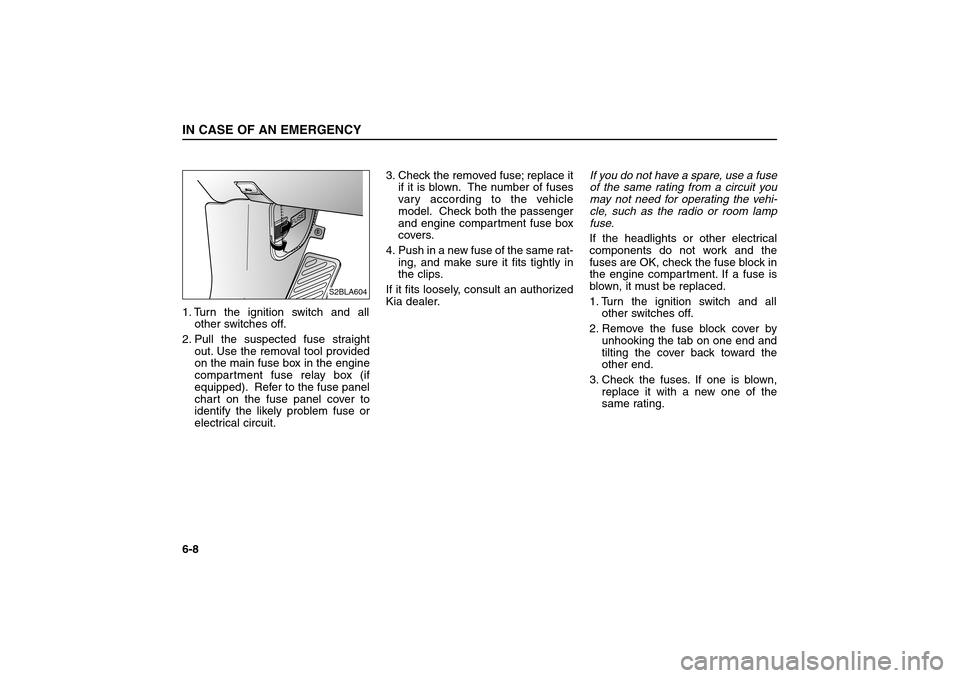
1. Turn the ignition switch and all
other switches off.
2. Pull the suspected fuse straight
out. Use the removal tool provided
on the main fuse box in the engine
compartment fuse relay box (if
equipped). Refer to the fuse panel
chart on the fuse panel cover to
identify the likely problem fuse or
electrical circuit.3. Check the removed fuse; replace it
if it is blown. The number of fuses
vary according to the vehicle
model. Check both the passenger
and engine compartment fuse box
covers.
4. Push in a new fuse of the same rat-
ing, and make sure it fits tightly in
the clips.
If it fits loosely, consult an authorized
Kia dealer.If you do not have a spare, use a fuse
of the same rating from a circuit you
may not need for operating the vehi-
cle, such as the radio or room lamp
fuse.
If the headlights or other electrical
components do not work and the
fuses are OK, check the fuse block in
the engine compartment. If a fuse is
blown, it must be replaced.
1. Turn the ignition switch and all
other switches off.
2. Remove the fuse block cover by
unhooking the tab on one end and
tilting the cover back toward the
other end.
3. Check the fuses. If one is blown,
replace it with a new one of the
same rating.IN CASE OF AN EMERGENCY6-8
FUSE
S2BLA604
BL-ENG (CAN)-6.qxd 7/28/05 5:57 PM Page 8
Page 241 of 312
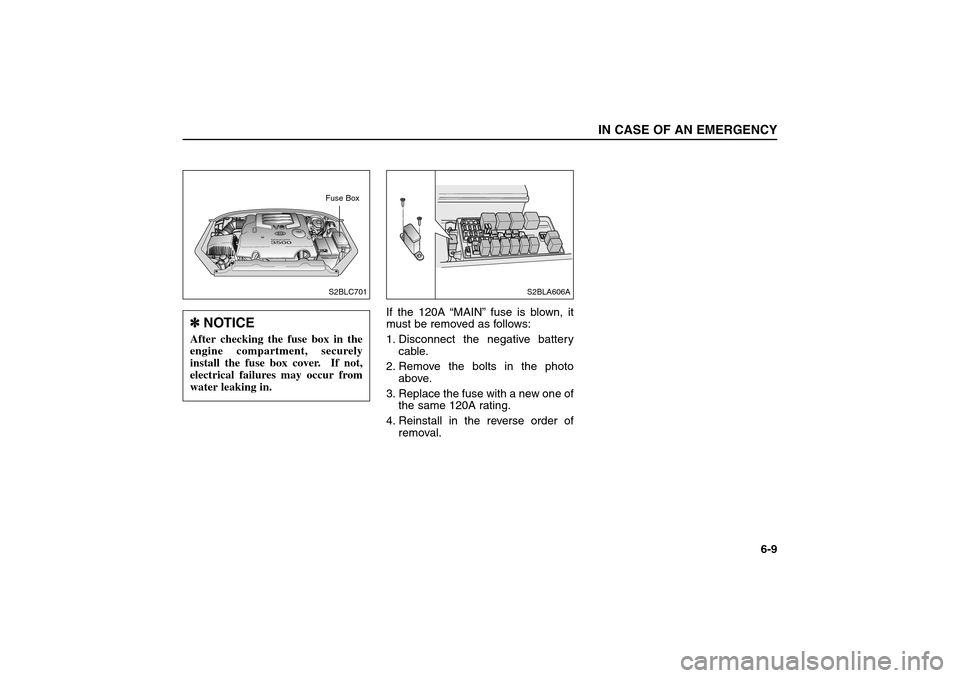
If the 120A “MAIN”fuse is blown, it
must be removed as follows:
1. Disconnect the negative battery
cable.
2. Remove the bolts in the photo
above.
3. Replace the fuse with a new one of
the same 120A rating.
4. Reinstall in the reverse order of
removal.
IN CASE OF AN EMERGENCY
6-9
3500DOHC24V
S2BLC701Fuse Box
S2BLA606A
✽ ✽
NOTICEAfter checking the fuse box in the
engine compartment, securely
install the fuse box cover. If not,
electrical failures may occur from
water leaking in.
BL-ENG (CAN)-6.qxd 7/28/05 5:57 PM Page 9
Page 242 of 312
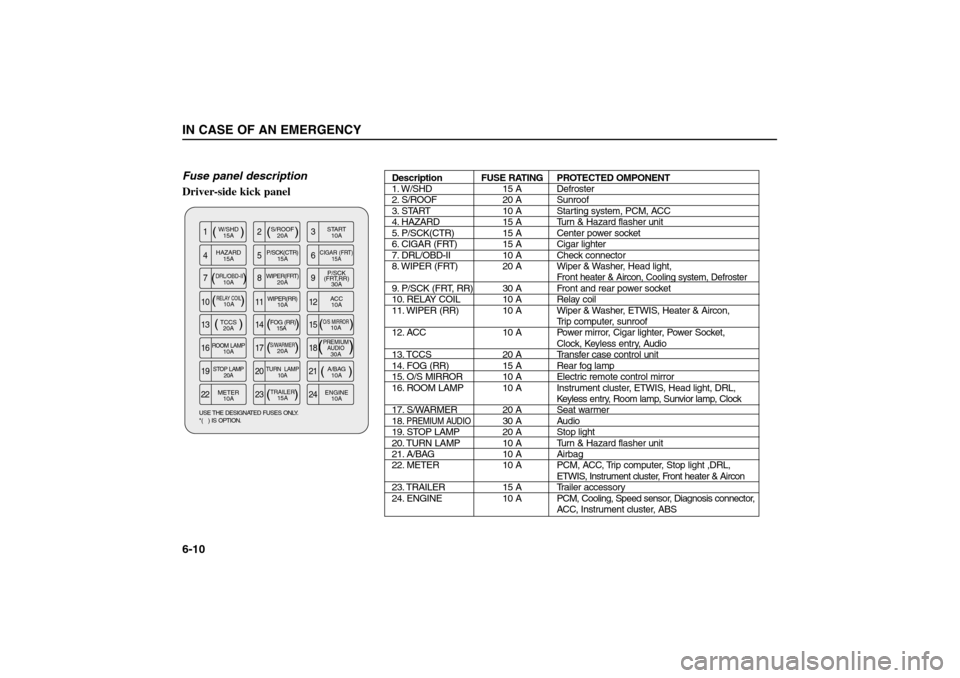
Fuse panel description
Driver-side kick panelIN CASE OF AN EMERGENCY6-10
( )
( ) (
) ( ) ( )
( )
W/SHD
15AS/ROOF
20A
( )PREMIUM
AUDIO30A
( )S/WARMER20A
(
)
O/S MIRROR10A
(
)
RELAY COIL10ASTART
10A
METER
10AENGINE
10A HAZARD
15AP/SCK(CTR)
15A
CIGAR (FRT)
15A
DRL/OBD-II10AWIPER(FRT)
20A
TCCS
20AROOM LAMP10A FOG (RR)
15AP/SCK
(FRT,RR)
30ASTOP LAMP
20ATURN LAMP
10A
A/BAG
10A
( )TRAILER15A WIPER(RR)
10AACC
10A
22 23 24 19 20 21
16 17 18
13 14 15 10 11 12789 456 123USE THE DESIGNATED FUSES ONLY.
*( ) IS OPTION.
Description FUSE RATING PROTECTED OMPONENT
1. W/SHD 15 A Defroster
2. S/ROOF 20 A Sunroof
3. START 10 A Starting system, PCM, ACC
4. HAZARD 15 A Turn & Hazard flasher unit
5. P/SCK(CTR) 15 A Center power socket
6. CIGAR (FRT) 15 A Cigar lighter
7. DRL/OBD-II 10 A Check connector
8. WIPER (FRT) 20 A Wiper & Washer, Head light,
Front
heater & Aircon, Cooling system, Defroster
9. P/SCK (FRT, RR) 30 A Front and rear power socket
10. RELAY COIL 10 A Relay coil
11. WIPER (RR) 10 A Wiper & Washer, ETWIS, Heater & Aircon,
Trip computer, sunroof
12. ACC 10 A Power mirror, Cigar lighter, Power Socket,
Clock, Keyless entry, Audio
13. TCCS 20 A Transfer case control unit
14. FOG (RR) 15 A Rear fog lamp
15. O/S MIRROR 10 A Electric remote control mirror
16. ROOM LAMP 10 A Instrument cluster, ETWIS, Head light, DRL,
Keyless entry, Room lamp, Sunvior lamp, Clock
17. S/WARMER 20 A Seat warmer
18.
PREMIUM AUDIO
30 A Audio
19. STOP LAMP 20 A Stop light
20. TURN LAMP 10 A Turn & Hazard flasher unit
21. A/BAG 10 A Airbag
22. METER 10 A PCM, ACC, Trip computer, Stop light ,DRL,
ETWIS, Instrument cluster, Front heater & Aircon
23. TRAILER 15 A Trailer accessory
24. ENGINE 10 APCM, Cooling, Speed sensor, Diagnosis connector,
ACC, Instrument cluster, ABS
BL-ENG (CAN)-6.qxd 7/28/05 5:57 PM Page 10
Page 243 of 312
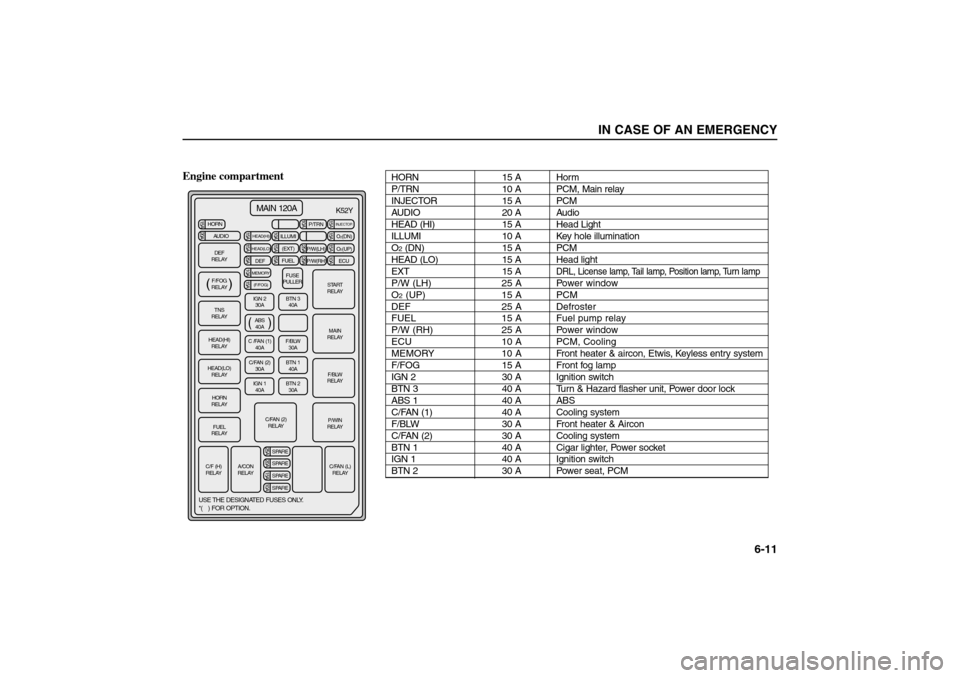
Engine compartment
IN CASE OF AN EMERGENCY
6-11
( )MAIN 120A
HORN20A15A 15A 25A
15A10A 15A 10A 10A 25A 25A
15A 15A 15A 15A 10A
AUDIO
HEAD(HI)
HEAD(LO)
INJECTOR
DEF25A 20A 15A 10ASPARE
SPARE
SPARE
SPARE
MEMORY15A(F/FOG)
ILLUMIP/TRN
P/W(LH)O
2(DN)
O2(UP)
P/W(RH) ECU (EXT)
FUEL
FUSE
PULLER
START
RELAY
MAIN
RELAY
F/BLW
RELAY
P/WIN
RELAY
C/FAN (L)
RELAY A/CON
RELAY
USE THE DESIGNATED FUSES ONLY.
*( ) FOR OPTION.
K52Y
C/F (H)
RELAYC/FAN (2)
RELAY
FUEL
RELAYHORN
RELAY HEAD(LO)
RELAY HEAD(HI)
RELAYTNS
RELAYDEF
RELAY
F/FOG
RELAY
IGN 2
30ABTN 3
40A
ABS
40A
C /FAN (1)
40AF/BLW
30A
C/FAN (2)
30ABTN 1
40A
IGN 1
40ABTN 2
30A( )
( )
HORN 15 A Horm
P/TRN 10 A PCM, Main relay
INJECTOR 15 A PCM
AUDIO 20 A Audio
HEAD (HI) 15 A Head Light
ILLUMI 10 A Key hole illumination
O2(DN) 15 A PCM
HEAD (LO) 15 A Head light
EXT 15 A
DRL, License lamp, Tail lamp, Position lamp, Turn lamp
P/W (LH) 25 A Power window
O2(UP) 15 A PCM
DEF 25 A Defroster
FUEL 15 A Fuel pump relay
P/W (RH) 25 A Power window
ECU 10 A PCM, Cooling
MEMORY 10 A Front heater & aircon, Etwis, Keyless entry system
F/FOG 15 A Front fog lamp
IGN 2 30 A Ignition switch
BTN 3 40 A Turn & Hazard flasher unit, Power door lock
ABS 1 40 A ABS
C/FAN (1) 40 A Cooling system
F/BLW 30 A Front heater & Aircon
C/FAN (2) 30 A Cooling system
BTN 1 40 A Cigar lighter, Power socket
IGN 1 40 A Ignition switch
BTN 2 30 A Power seat, PCM
BL-ENG (CAN)-6.qxd 7/28/05 5:57 PM Page 11
Page 244 of 312
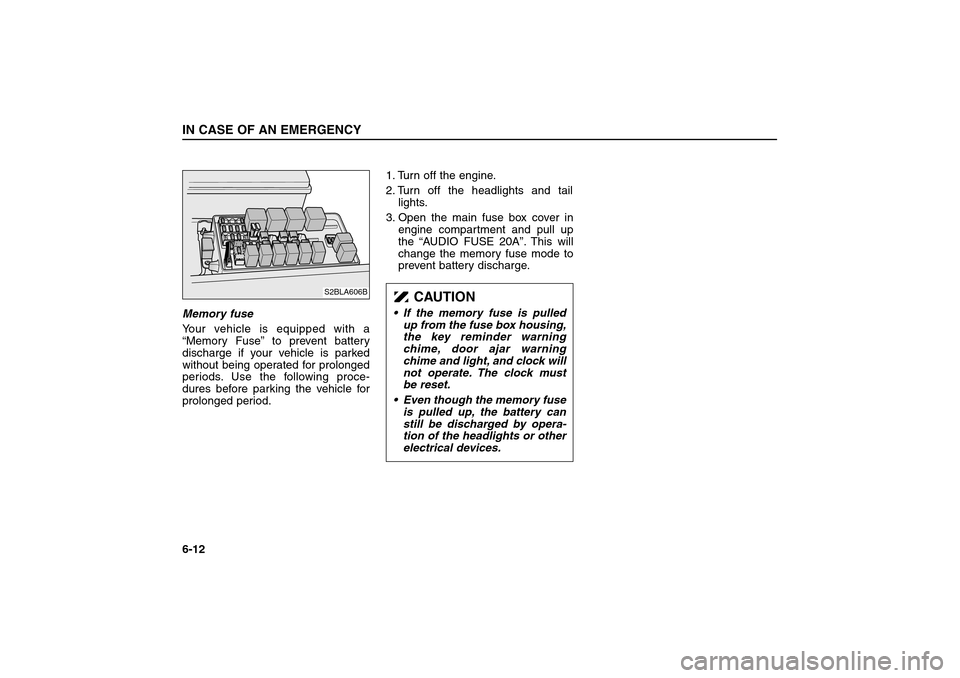
Memory fuse
Your vehicle is equipped with a
“Memory Fuse”to prevent battery
discharge if your vehicle is parked
without being operated for prolonged
periods. Use the following proce-
dures before parking the vehicle for
prolonged period.1. Turn off the engine.
2. Turn off the headlights and tail
lights.
3. Open the main fuse box cover in
engine compartment and pull up
the “AUDIO FUSE 20A”. This will
change the memory fuse mode to
prevent battery discharge.IN CASE OF AN EMERGENCY6-12
S2BLA606B
CAUTION
• If the memory fuse is pulled
up from the fuse box housing,
the key reminder warning
chime, door ajar warning
chime and light, and clock will
not operate. The clock must
be reset.
Even though the memory fuse
is pulled up, the battery can
still be discharged by opera-
tion of the headlights or other
electrical devices.
BL-ENG (CAN)-6.qxd 7/28/05 5:57 PM Page 12